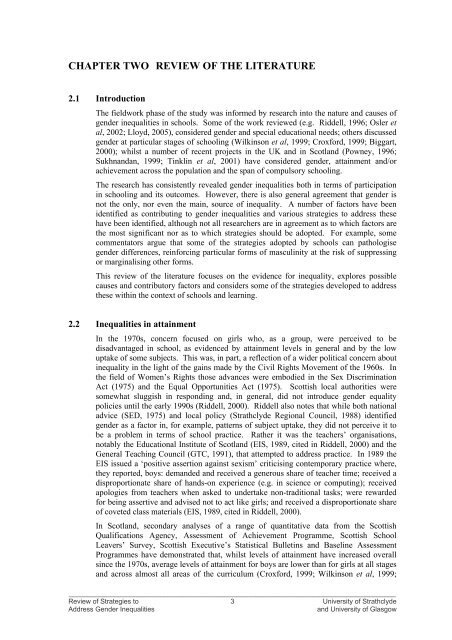Review of Strategies to Address Gender Inequalities in Scottish ...
Review of Strategies to Address Gender Inequalities in Scottish ...
Review of Strategies to Address Gender Inequalities in Scottish ...
Create successful ePaper yourself
Turn your PDF publications into a flip-book with our unique Google optimized e-Paper software.
CHAPTER TWO REVIEW OF THE LITERATURE2.1 IntroductionThe fieldwork phase <strong>of</strong> the study was <strong>in</strong>formed by research <strong>in</strong><strong>to</strong> the nature and causes <strong>of</strong>gender <strong>in</strong>equalities <strong>in</strong> schools. Some <strong>of</strong> the work reviewed (e.g. Riddell, 1996; Osler etal, 2002; Lloyd, 2005), considered gender and special educational needs; others discussedgender at particular stages <strong>of</strong> school<strong>in</strong>g (Wilk<strong>in</strong>son et al, 1999; Croxford, 1999; Biggart,2000); whilst a number <strong>of</strong> recent projects <strong>in</strong> the UK and <strong>in</strong> Scotland (Powney, 1996;Sukhnandan, 1999; T<strong>in</strong>kl<strong>in</strong> et al, 2001) have considered gender, atta<strong>in</strong>ment and/orachievement across the population and the span <strong>of</strong> compulsory school<strong>in</strong>g.The research has consistently revealed gender <strong>in</strong>equalities both <strong>in</strong> terms <strong>of</strong> participation<strong>in</strong> school<strong>in</strong>g and its outcomes. However, there is also general agreement that gender isnot the only, nor even the ma<strong>in</strong>, source <strong>of</strong> <strong>in</strong>equality. A number <strong>of</strong> fac<strong>to</strong>rs have beenidentified as contribut<strong>in</strong>g <strong>to</strong> gender <strong>in</strong>equalities and various strategies <strong>to</strong> address thesehave been identified, although not all researchers are <strong>in</strong> agreement as <strong>to</strong> which fac<strong>to</strong>rs arethe most significant nor as <strong>to</strong> which strategies should be adopted. For example, somecommenta<strong>to</strong>rs argue that some <strong>of</strong> the strategies adopted by schools can pathologisegender differences, re<strong>in</strong>forc<strong>in</strong>g particular forms <strong>of</strong> mascul<strong>in</strong>ity at the risk <strong>of</strong> suppress<strong>in</strong>gor marg<strong>in</strong>alis<strong>in</strong>g other forms.This review <strong>of</strong> the literature focuses on the evidence for <strong>in</strong>equality, explores possiblecauses and contribu<strong>to</strong>ry fac<strong>to</strong>rs and considers some <strong>of</strong> the strategies developed <strong>to</strong> addressthese with<strong>in</strong> the context <strong>of</strong> schools and learn<strong>in</strong>g.2.2 <strong>Inequalities</strong> <strong>in</strong> atta<strong>in</strong>mentIn the 1970s, concern focused on girls who, as a group, were perceived <strong>to</strong> bedisadvantaged <strong>in</strong> school, as evidenced by atta<strong>in</strong>ment levels <strong>in</strong> general and by the lowuptake <strong>of</strong> some subjects. This was, <strong>in</strong> part, a reflection <strong>of</strong> a wider political concern about<strong>in</strong>equality <strong>in</strong> the light <strong>of</strong> the ga<strong>in</strong>s made by the Civil Rights Movement <strong>of</strong> the 1960s. Inthe field <strong>of</strong> Women’s Rights those advances were embodied <strong>in</strong> the Sex Discrim<strong>in</strong>ationAct (1975) and the Equal Opportunities Act (1975). <strong>Scottish</strong> local authorities weresomewhat sluggish <strong>in</strong> respond<strong>in</strong>g and, <strong>in</strong> general, did not <strong>in</strong>troduce gender equalitypolicies until the early 1990s (Riddell, 2000). Riddell also notes that while both nationaladvice (SED, 1975) and local policy (Strathclyde Regional Council, 1988) identifiedgender as a fac<strong>to</strong>r <strong>in</strong>, for example, patterns <strong>of</strong> subject uptake, they did not perceive it <strong>to</strong>be a problem <strong>in</strong> terms <strong>of</strong> school practice. Rather it was the teachers’ organisations,notably the Educational Institute <strong>of</strong> Scotland (EIS, 1989, cited <strong>in</strong> Riddell, 2000) and theGeneral Teach<strong>in</strong>g Council (GTC, 1991), that attempted <strong>to</strong> address practice. In 1989 theEIS issued a ‘positive assertion aga<strong>in</strong>st sexism’ criticis<strong>in</strong>g contemporary practice where,they reported, boys: demanded and received a generous share <strong>of</strong> teacher time; received adisproportionate share <strong>of</strong> hands-on experience (e.g. <strong>in</strong> science or comput<strong>in</strong>g); receivedapologies from teachers when asked <strong>to</strong> undertake non-traditional tasks; were rewardedfor be<strong>in</strong>g assertive and advised not <strong>to</strong> act like girls; and received a disproportionate share<strong>of</strong> coveted class materials (EIS, 1989, cited <strong>in</strong> Riddell, 2000).In Scotland, secondary analyses <strong>of</strong> a range <strong>of</strong> quantitative data from the <strong>Scottish</strong>Qualifications Agency, Assessment <strong>of</strong> Achievement Programme, <strong>Scottish</strong> SchoolLeavers’ Survey, <strong>Scottish</strong> Executive’s Statistical Bullet<strong>in</strong>s and Basel<strong>in</strong>e AssessmentProgrammes have demonstrated that, whilst levels <strong>of</strong> atta<strong>in</strong>ment have <strong>in</strong>creased overalls<strong>in</strong>ce the 1970s, average levels <strong>of</strong> atta<strong>in</strong>ment for boys are lower than for girls at all stagesand across almost all areas <strong>of</strong> the curriculum (Croxford, 1999; Wilk<strong>in</strong>son et al, 1999;______________________________________________________________________________________<strong>Review</strong> <strong>of</strong> <strong>Strategies</strong> <strong>to</strong> 3 University <strong>of</strong> Strathclyde<strong>Address</strong> <strong>Gender</strong> <strong>Inequalities</strong>and University <strong>of</strong> Glasgow
















